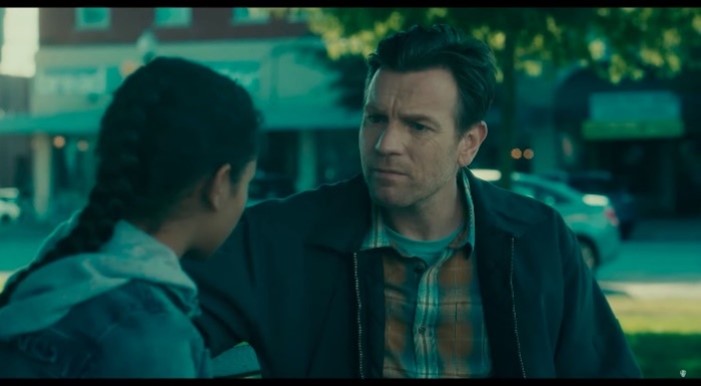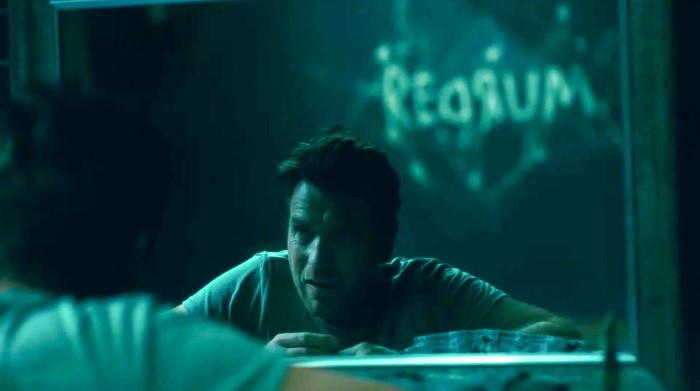First there was the Stephen King novel. Then the iconic Kubrick film. Next was King’s literary follow-up. And now, over 40 years since he was put to screen in The Shining (1980), Danny Torrance has come out to play again in Doctor Sleep (2019). Not only was the film an adaptation of King’s 2013 novel, but also a cinematic sequel to Kubrick’s classic film. The pressure was on for writer-director Mike Flanagan to satisfy both King and Kubrick fans alike, while also delivering a gripping psychological horror film with enough clout to stand on its own. Flanagan did just that, resulting in a chilling, poignant and immaculately crafted film. Despite some narrative issues, Doctor Sleep’s stellar direction, compelling performances, and a thematically rich tale of overcoming deep trauma and addiction make it an immersive psychological horror which both honours King and Kubrick and breathes new life into the story of Danny Torrance and his ‘shine’.
The film reunites us with an adult Danny Torrance (Ewan McGregor) many years after the terrifying events of the Overlook Hotel. Drowning in alcoholism, Danny desperately tries to forget his past, block out his ‘shine’ and run away from himself while being tormented by the ghosts of the Overlook. Years of soul-searching, alcoholics anonymous meetings and the help of his friend Billy Freeman (Cliff Curtis) seemed to be putting Danny on a path of peace and recovery, where he could finally forget. However, when he meets a girl who shares his ability to ‘shine’ named Abra (Kyliegh Curran), they must team up to face the True Knot, a sadistic cult led by the sinister Rose the Hat (Rebecca Ferguson) whose members feed off the ‘shine’ of innocents to remain immortal.
From directorial gems Oculus (2013), Hush (2016) and Gerald’s Game (2017) to The Haunting Of Hill House (2018)and The Haunting Of Bly Manor (2020), Mike Flanagan has made a name for himself in the horror genre for his meticulous direction and sharp focus on character psychology and thematic depth. Doctor Sleep is a welcomed testament to Flanagan’s formidable directing prowess. Flanagan’s fastidious attention to Danny Torrance is remarkable as he plunges the audience deep into Danny’s psyche and inner trauma. Flanagan plays with composition by placing Danny at different places of the frame to indicate his isolation, hopelessness, and paranoia. Certain shots place him with large amounts of surrounding space, signaling his loneliness and lack of real connection to others around him. Low key lighting shrouding Danny also emphasises his dull and monotonous life entirely devoted to drowning out his ‘shine’ with booze and forgetting his past. He has lost his vitality in life and is completely haunted by the Overlook Hotel.

Yet at the same time, Danny is reckoning with his chosen way of life. Several shots throughout the film also bring to light Danny’s self-examination on his path to recovery and fully embracing his shine such as those involving mirrors. As he meets Abra and eventually builds up the courage to challenge the True Knot, Flanagan places Danny sharing shots with her, emphasizing their connection. In these shots, Danny is placed directly in front, behind or next to the source of light in the frame. This shows that even though there may still be much isolating space around him, he has become the shining light in the darkness possessing enough courage to persevere and face his demons.
Those are some examples of how Flanagan intricately delved into the protagonist’s psychology throughout the film. Ewan McGregor’s reserved, yet somber and ruminative performance of Danny equally contributes to the success of his portrayal. McGregor gradually shifts between from a haggard, tired and defeated Danny trying to forget his past to a determined and courageous Danny finally embracing the ‘shine’ he had fought so hard to conceal. McGregor’s controlled and calculated performance culminated in a compelling and convincing portrayal of a recovering alcoholic ready to battle his traumatic past. As a foil to McGregor, Kyliegh Curran delivered a powerful performance as Abra, balancing childlike innocence and fearlessness with terror and foreboding. McGregor and Curran’s chemistry is electric, beautifully binding their characters together as Danny mentors Abra as Dick Hallorann did for him. Rebecca Ferguson’s eerie and unsettling performance as Rose the Hat deserves great praise too for the chilling tone she championed. Rose the Hat was a compelling and complex antagonist, a fitting addition to Doctor Sleep’s mystique.

Flanagan built an icy, hostile and lifeless atmosphere throughout Doctor Sleep using low-key lighting and cold and muted colours such as greys and pale blues. These choices emphasise Danny’s character journey, but also proves the world is “a hungry place, a dangerous place, a dark place” as Danny describes. This aesthetic reflects the True Knot’s immortal purpose too: to suck the life out of those who ‘shine’. Cinematographer Michael Fimognari must be credited for his solid work cinematically crafting the atmosphere and feel of this film. A fantastic scene involving the True Knot killing and feeding off an unsuspecting child’s shine epitomized this cold, energy-sucking and draining atmosphere with superb editing, acting, cinematography and directing all converging to send chills down my spine while watching in the theatre.
A host of elements of the film were also digitally created from the classic blood flooding out of the elevator to REDRUM to the smoke of the ‘shine’, yet they looked so real and didn’t detract from the story or performances. On the other side of the special effects spectrum, Flanagan also used rudimentary camera movements to achieve awesome effects. For example, a scene where Danny slides down the floor of his apartment to the wall was achieved by simply tilting the camera at an angle and pulling Ewan McGregor across the floor with a rope to make it look as if the floor itself was tilting. Doctor Sleep is a great example of how a film can utilize CGI and practical camera effects to achieve surreal and striking imagery.
Along with the stellar direction and the film’s atmosphere, Doctor Sleep offered plenty of thematic material, elevating itself to higher abstract and symbolic meanings, true to its masterful harnessing of the psychological horror. The film maturely handles themes of addiction, alcoholism, and recovery, prominently through Danny’s eyes, and metaphorically portrays the demons of the Overlook Hotel and the True Knot as a representation of battling addiction itself. In a Freudian sense, these ghoulish figures from his past and present represent Danny’s unresolved childhood conflict with his parents – his father for abusing him and his mother for not doing enough to protect him – and will continue to manifest until Danny reckons with his repressed trauma and does work to resolve it. A certain sequence from inside the Overlook Hotel certainly suggests this link between alcoholism and unresolved childhood conflict.
Another interpretation is that Doctor Sleep is a psychological representation of post-traumatic stress disorder (PTSD), depression and schizophrenia with Danny’s addiction, recovery and courage as a central trio. Could it be that Danny’s psychic and supernatural abilities are in and of themselves a symbol for these mental disorders, but re-directed into something powerful and mystical? It is clear to me that Danny exhibits plenty of PTSD symptoms and visceral hallucinations by virtue of his ‘shine’ throughout the film. Flanagan, and King by extension, could be critiquing the status of ‘mental disorders’ and questioning why these differently abled mental conditions are portrayed as tragic, disabling and pitiful instead of being represented as incredibly powerful, extraordinary and superhuman. This interpretation, however, problematically skirts over and perhaps romanticises the real harm these mental disorders cause to those living with them.
What is clear is that Doctor Sleep at its core is a tale of recovery, redemption and the triumph of the human spirit over psychological adversity and fear. Great films offer much in terms of meaning making and stimulate long discussions over their symbolic and abstract meaning with everyone contributing a different perspective and interpretation. Just like The Shining, Doctor Sleep delivers here and provides a thematic feast for its audience, proving itself to be a deep and thoughtful film which encourages rumination and reflection.

The film paid homage to The Shining through several shot recreations and even used digitally altered footage from Kubrick’s film. While these were treats for fans of The Shining, I feel Doctor Sleep veered a tad too far into the nostalgia of its predecessor and missed opportunities to present the Overlook Hotel in a new and potentially even more terrifying light. Flanagan had proved himself to be a masterful director throughout the film, and it would have been more interesting to see his take on the Overlook than modern recreations of Kubrick’s. But of course, a sequel to The Shining is going to pay homage to it.
Unfortunately, Doctor Sleep lacks slightly in the plot and narrative dimension. The beginning was very long-winded and meandering, and the end was rushed and disappointing. Flanagan wanted us to truly experience the depths of Danny’s darkness, but when one looks at the film holistically, more time should have been taken from the beginning to spend on developing the end. Additionally, Doctor Sleep had flat and unconvincing arcs for his minor characters. Side stories for characters like Snakebite Andi (Emily Alyn Lind) and Billy Freeman seemed to be developing somewhere only to be abruptly cut off and disregarded. I was also disappointed by the eventual fate of the True Knot, Rose the Hat and the Overlook Hotel – they felt undercooked. The film focused meticulously on building up the mythology of these characters and an eerie atmosphere, but this focus did not extend to how certain character plot lines were resolved. Yes, the focus of the film is on Danny, Abra and Rose the Hat, but that doesn’t mean the surrounding characters shouldn’t be as purposefully handled.
Overall, Doctor Sleep proved to be a worthy sequel to The Shining, creatively building upon the existing universe of one of the greatest horror movies ever made. Flanagan’s entertaining film was wonderfully directed, shot, and edited with compelling performances and a haunting score by the Newton Brothers. Doctor Sleep is a shining example of what an impressive and thought-provoking psychological horror should be and a director who knows how to craft one.
What did you think about Doctor Sleep? Let me know in the comments below!

Leave a comment